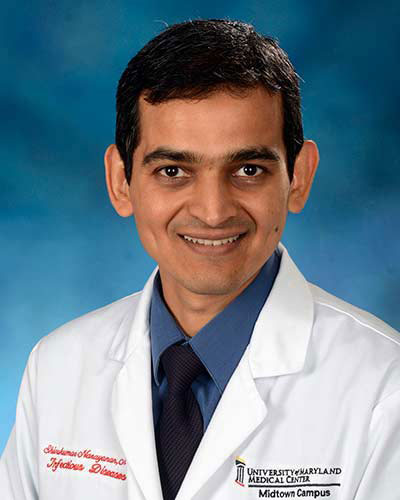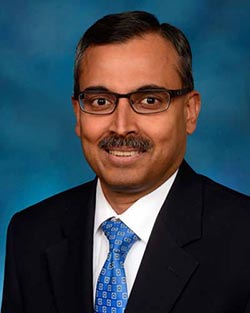March 13, 2024 | Jennifer Gonzales

Dr. Shivakumar Narayanan, an infectious disease specialist affiliated with the University of Maryland Medical Center and the Institute of Human Virology (IHV), was recently awarded over $2.6 million in grants from prominent organizations to support groundbreaking public health initiatives in the Baltimore area.
"I am thrilled to have the opportunity to lead these meaningful patient-centered care projects. Research activities to help improve delivery and quality of clinical care is what gives me fulfillment and is very much tied to my interests," said Dr. Narayanan. "The issues explored in these studies underscore the importance of meeting patients where they are, breaking down barriers to care, and innovating to improve health outcomes across diverse populations."
The first grant, totaling $150,000 from Melinta Therapeutics, was awarded for AIM STOP. This will fund a study on using long-acting antimicrobials coupled with medication-assisted treatment to facilitate care transitions for hospitalized people who inject drugs. By exploring an alternative to prolonged IV antibiotic courses, this intervention aims to improve outcomes and reduce risks for a vulnerable population.
Additionally, Dr. Narayanan, along with Co-Principal Investigator Dr. Aditi Ringwala, secured $2.3 million in funding through a Substance Abuse and Mental Health Services Administration (SAMHSA) Minority AIDS Initiative Grant, in collaboration with the University of Maryland Drug Treatment Center. Spanning five years, this grant will expand services to engage African American and minority patients in HIV/viral hepatitis prevention and treatment. Culturally informed programs will build workforce skills, boost screening, and increase pre-exposure prophylaxis access.
this grant will expand services to engage African American and minority patients in HIV/viral hepatitis prevention and treatment. Culturally informed programs will build workforce skills, boost screening, and increase pre-exposure prophylaxis access.
Finally, a $220,000 award from Gilead Sciences through the Center for Disease Analysis Foundation will fund HCV (hepatitis C virus) ReLink. Co-principled with Dr. Natalie Spicyn, this award will help identify and re-engage diagnosed but untreated patients with HVC. Patient navigators will leverage electronic records and conduct targeted outreach by partnering with the JACQUES Initiative community health program.
"In Baltimore, we encounter infectious disease complications in marginalized patients with substance use disorder," said Dr. Shyam Kotillil, Acting Director at the Institute of Human Virology. "Confronting medication-assisted treatment for opioid use disorder along with on-site management of infectious complications like hepatitis C is critical in controlling this syndemic. Dr. Narayanan's treatment for opioid use disorder along with on-site management of infectious complications like hepatitis C are critical in controlling this."
Dr. Narayanan has over 20 years of experience as an infectious disease specialist. He received his medical degree from the University of Mumbai, India. Through his multifaceted work as a clinician, researcher, and advocate, he strives to advance health equity and access for all.
About the University of Maryland School of Medicine
Now in its third century, the University of Maryland School of Medicine was chartered in 1807 as the first public medical school in the United States. It continues today as one of the fastest growing, top-tier biomedical research enterprises in the world -- with 46 academic departments, centers, institutes, and programs, and a faculty of more than 3,000 physicians, scientists, and allied health professionals, including members of the National Academy of Medicine and the National Academy of Sciences, and a distinguished two-time winner of the Albert E. Lasker Award in Medical Research. With an operating budget of more than $1.2 billion, the School of Medicine works closely in partnership with the University of Maryland Medical Center and Medical System to provide research-intensive, academic and clinically based care for nearly 2 million patients each year.
The School of Medicine has nearly $600 million in extramural funding, with most of its academic departments highly ranked among all medical schools in the nation in research funding. As one of the seven professional schools that make up the University of Maryland, Baltimore campus, the School of Medicine has a total population of nearly 9,000 faculty and staff, including 2,500 students, trainees, residents, and fellows. The combined School of Medicine and Medical System ("University of Maryland Medicine") has an annual budget of over $6 billion and an economic impact of nearly $20 billion on the state and local community.
The School of Medicine, which ranks as the 8th highest among public medical schools in research productivity (according to the Association of American Medical Colleges profile) is an innovator in translational medicine, with 606 active patents and 52 start-up companies. In the latest U.S. News & World Report ranking of the Best Medical Schools, published in 2021, the UM School of Medicine is ranked #9 among the 92 public medical schools in the U.S., and in the top 15 percent (#27) of all 192 public and private U.S. medical schools. The School of Medicine works locally, nationally, and globally, with research and treatment facilities in 36 countries around the world. Visit medschool.umaryland.edu.
Contact
Institute of Human Virology
Jennifer Gonzales
Public Relations & Communications Manager
jennifer.gonzales@ihv.umaryland.edu
Jennifer Gonzales
jennifer.gonzales@ihv.umaryland.edu

